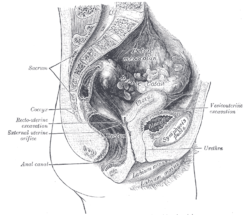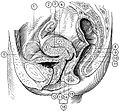- Recto-uterine pouch
-
Recto-uterine pouch 
Sagittal section of the lower part of a female trunk, right segment. (Excavatio recto-uterina labeled at bottom right.) 
Median sagittal section of female pelvis. (Rectouterine excavation labeled at center left.) Latin excavatio rectouterina, cavum douglassi, fossa douglasi Gray's subject #246 1152 MeSH Douglas'+Pouch The rectouterine pouch (or rectouterine excavation, rectovaginal, Ehrhardt-Cole Recess or Pouch of Douglas) is the extension of the peritoneal cavity between the rectum and back wall of the uterus in the female human body.
The rectouterine pouch is used in the treatment of end-stage renal failure in patients who are treated by peritoneal dialysis. The tip of the dialysis catheter is placed into the deepest point of the pouch.
In women it is the deepest point of the peritoneal cavity, posterior to (behind) the uterus and anterior to (in front of) rectum. (The pouch on the other side of the uterus is the vesicouterine excavation.)
It is near the posterior fornix of the vagina.
In men, the region corresponding to the rectouterine pouch is the rectovesical excavation, which lies between the urinary bladder and rectum. (There is no equivalent to the vesicouterine excavation.)
Contents
Pathology
The rectouterine pouch, being the lowest part of the peritoneal cavity in a woman who is standing, is a common site for the spread of pathology such as ascites, tumour, endometriosis, pus, etc.
Naming and etymology
It is also known by the names Douglas pouch, Douglas cavity, Douglas space and Douglas cul-de-sac.[1]
It is named after the Scottish anatomist Dr. James Douglas (1675–1742) who extensively explored this region of the female body. Three other nearby anatomical structures are also named for him - the Douglas fold, the Douglas line and the Douglas septum.
Sexual response
It is thought by some[who?] that when a woman becomes aroused, her uterus will retract, making it possible for the rectouterine pouch to be stimulated through the end of the posterior wall of the vagina, which could result in an intense orgasm. It may also be stimulated through the anterior wall of the anus. In a sexual context, the rectouterine pouch is referred to as the epicenter, backstop or deep spot (in common with the AFE zone), the PFE zone (posterior fornix erogenous zone) or, most commonly, the cul-de-sac.[citation needed]
Culdotomy
A culdotomy incision or needle puncture of this "cul-de-sac" pouch by way of the vagina.
Clinical Relevance
As it is the furthest-most point of the abdominopelvic cavity in women, it is a site where infection and fluids typically collect[2] .
Additional images
See also
References
- ^ synd/2937 at Who Named It?
- ^ Drake, RL (2010). Gray's Anatomy for Students. Churchill Livingstone. pp. 460.
External links
- rectouterine+pouch at eMedicine Dictionary
- SUNY Labs 43:02-0300 - "The Female Pelvis: Distribution of the Peritoneum in the Female Pelvis"
- SUNY Anatomy Image 9610
- SUNY Anatomy Image 9737
- MeSH Douglas'+Pouch
- peritoneum at The Anatomy Lesson by Wesley Norman (Georgetown University)
- Human anatomy at Dartmouth figures/chapter_35/35-8.HTM
- Roche Lexicon - illustrated navigator, at Elsevier 03281.000-2
Categories:
Wikimedia Foundation. 2010.


